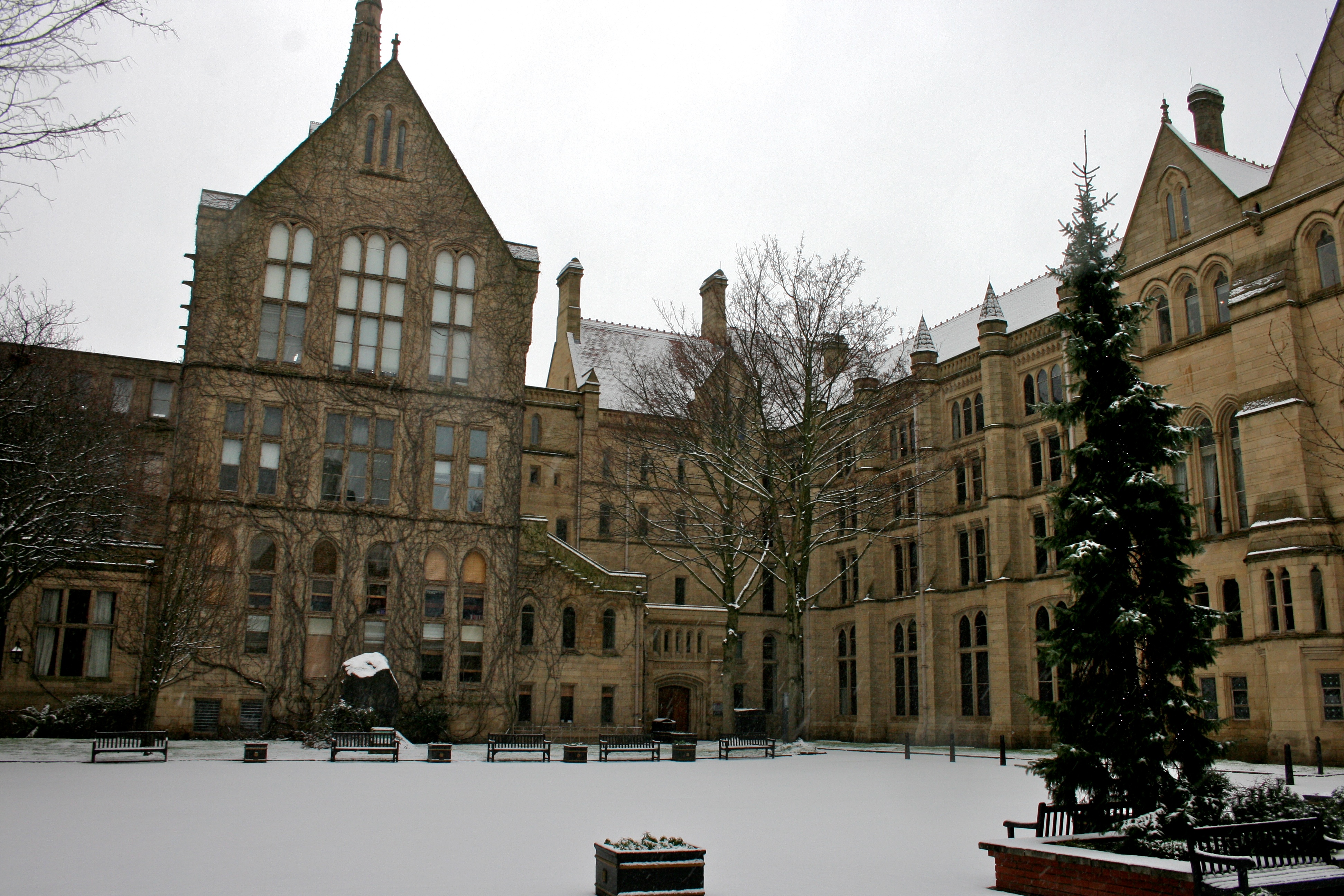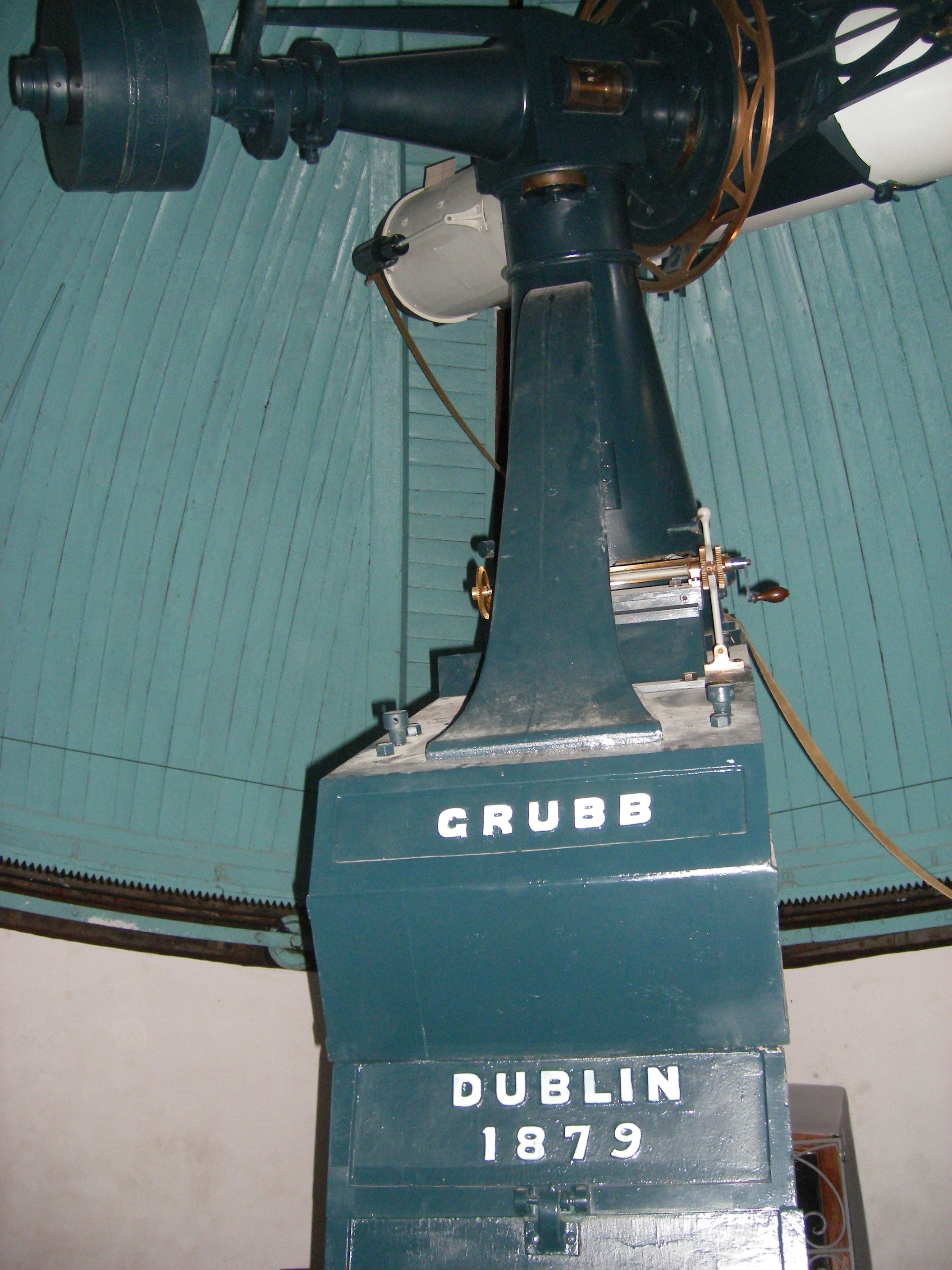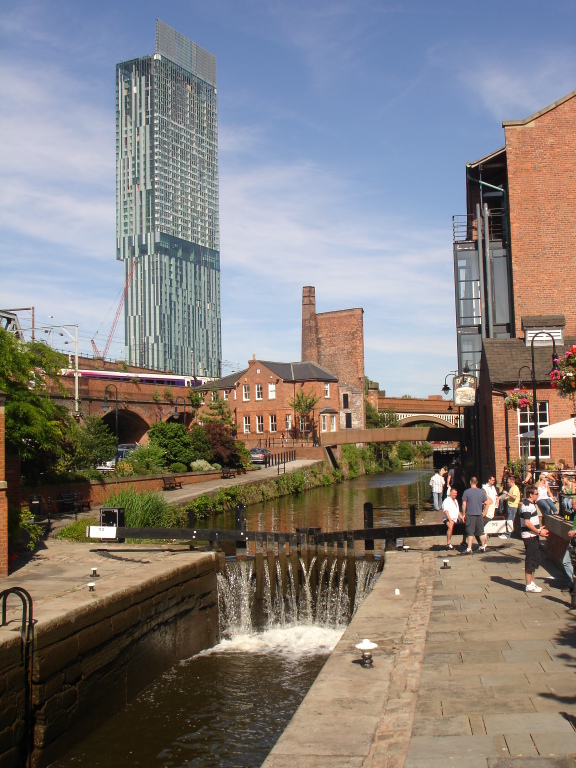|
Godlee Observatory
The Godlee Observatory is an old astronomical observatory located in a tower on the roof of the University of Manchester's Sackville Street Building, G floor (formerly UMIST Main Building), in the City Centre of Manchester, England. It was given to the city of Manchester by Francis Godlee when construction was completed in 1902. The dome is constructed out of papier-mâché and is reached by an Edwardian era wrought iron staircase and a trap door. Godlee Observatory is home to two original telescopes made by Grubb of Dublin: a Newtonian telescope that uses a concave primary mirror and a flat diagonal secondary mirror, and a refracting telescope that uses a lens as its objective to form an image. The observatory is operated by the Manchester Astronomical Society The Manchester Astronomical Society is an organisation that promotes popular and amateur astronomy in North West England. It is one of the oldest provincial astronomical societies in England. The Society is b ... [...More Info...] [...Related Items...] OR: [Wikipedia] [Google] [Baidu] |
Manchester Astronomical Society
The Manchester Astronomical Society is an organisation that promotes popular and amateur astronomy in North West England. It is one of the oldest provincial astronomical societies in England. The Society is based in the Godlee Observatory located in the Sackville Building, University of Manchester, in Manchester city centre. Membership is open to anyone with an interest in astronomy. History The society's origins lay in the North Western Branch of the British Astronomical Association, which was established in 1892 (soon after the Association's formation in 1890). However, a number of members gradually became dissatisfied with the Association's treatment of the branch (particularly in relation to funding) and the Branch's members consequently decided to dissolve the branch to form the Manchester Astronomical Society at a meeting at the Godlee Observatory in September 1903. Rev. Thomas H. Core was elected as the society's inaugural President. The society held regular lectures. ... [...More Info...] [...Related Items...] OR: [Wikipedia] [Google] [Baidu] |
University Of Manchester
The University of Manchester is a public university, public research university in Manchester, England. The main campus is south of Manchester city centre, Manchester City Centre on Wilmslow Road, Oxford Road. The university owns and operates major cultural assets such as the Manchester Museum, The Whitworth art gallery, the John Rylands Library, the Tabley House, Tabley House Collection and the Jodrell Bank Observatory—a UNESCO World Heritage Site. The University of Manchester is considered a red brick university, a product of the civic university movement of the late 19th century. The current University of Manchester was formed in 2004 following the merger of the University of Manchester Institute of Science and Technology (UMIST) and the Victoria University of Manchester. This followed a century of the two institutions working closely with one another. The University of Manchester Institute of Science and Technology was founded in 1824 as the Manchester Mechanics' Institute, ... [...More Info...] [...Related Items...] OR: [Wikipedia] [Google] [Baidu] |
Sackville Street Building
The Sackville Street Building is a building on Sackville Street, Manchester, England. The University of Manchester occupies the building which, before the merger with UMIST in 2004, was UMIST's "Main Building". Construction of the building for the Manchester School of Technology began in 1895 on a site formerly occupied by Sir Joseph Whitworth's engineering works; it was opened in 1902 by the then Prime Minister, Arthur Balfour. The School of Technology became the Manchester Municipal College of Technology in 1918. Built using Burmantofts terracotta, the building is now Grade II listed. It was extended along Whitworth Street, towards London Road, between 1927 and 1957 by the architects Bradshaw Gass & Hope, the delay being due to the depression in the 1930s and the Second World War. Originally a swimming pool was planned for the top floor, but after worries the weight of water might cause structural issues it was instead used as a dug in gymnasium and in more recent y ... [...More Info...] [...Related Items...] OR: [Wikipedia] [Google] [Baidu] |
Manchester
Manchester () is a city in Greater Manchester, England. It had a population of 552,000 in 2021. It is bordered by the Cheshire Plain to the south, the Pennines to the north and east, and the neighbouring city of City of Salford, Salford to the west. The two cities and the surrounding towns form one of the United Kingdom's most populous conurbations, the Greater Manchester Built-up Area, which has a population of 2.87 million. The history of Manchester began with the civilian settlement associated with the Roman Britain, Roman fort (''castra'') of ''Mamucium'' or ''Mancunium'', established in about AD 79 on a sandstone bluff near the confluence of the rivers River Medlock, Medlock and River Irwell, Irwell. Historic counties of England, Historically part of Lancashire, areas of Cheshire south of the River Mersey were incorporated into Manchester in the 20th century, including Wythenshawe in 1931. Throughout the Middle Ages Manchester remained a manorialism, manorial Township ( ... [...More Info...] [...Related Items...] OR: [Wikipedia] [Google] [Baidu] |
Sir Howard Grubb, Parsons And Co
Sir Howard Grubb, Parsons and Co. Ltd. was a telescope manufacturer, more commonly known as Grubb Parsons. It was based in Newcastle upon Tyne, in England. They were a noted telescope maker throughout the 19th and 20th century, making telescope throughout the World and some of the largest British telescopes, including one of their final projects, the William Herschel Telescope in the 1980s. In the late 1800s they were one of the few companies that could make large doublet objective lenses. History The company was founded in Dublin by Thomas Grubb as the Grubb Telescope Company in 1833.Backyard Voyager Page 1 Thomas Grubb was joined in 1864 by his son who built on the company's reputation for quality [...More Info...] [...Related Items...] OR: [Wikipedia] [Google] [Baidu] |
Astronomy
Astronomy () is a natural science that studies astronomical object, celestial objects and phenomena. It uses mathematics, physics, and chemistry in order to explain their origin and chronology of the Universe, evolution. Objects of interest include planets, natural satellite, moons, stars, nebulae, galaxy, galaxies, and comets. Relevant phenomena include supernova explosions, gamma ray bursts, quasars, blazars, pulsars, and cosmic microwave background radiation. More generally, astronomy studies everything that originates beyond atmosphere of Earth, Earth's atmosphere. Cosmology is a branch of astronomy that studies the universe as a whole. Astronomy is one of the oldest natural sciences. The early civilizations in recorded history made methodical observations of the night sky. These include the Babylonian astronomy, Babylonians, Greek astronomy, Greeks, Indian astronomy, Indians, Egyptian astronomy, Egyptians, Chinese astronomy, Chinese, Maya civilization, Maya, and many anc ... [...More Info...] [...Related Items...] OR: [Wikipedia] [Google] [Baidu] |
Observatory
An observatory is a location used for observing terrestrial, marine, or celestial events. Astronomy, climatology/meteorology, geophysical, oceanography and volcanology are examples of disciplines for which observatories have been constructed. Historically, observatories were as simple as containing an astronomical sextant (for measuring the distance between stars) or Stonehenge (which has some alignments on astronomical phenomena). Astronomical observatories Astronomical observatories are mainly divided into four categories: space-based, airborne, ground-based, and underground-based. Ground-based observatories Ground-based observatories, located on the surface of Earth, are used to make observations in the radio and visible light portions of the electromagnetic spectrum. Most optical telescopes are housed within a dome or similar structure, to protect the delicate instruments from the elements. Telescope domes have a slit or other opening in the roof that can be opened ... [...More Info...] [...Related Items...] OR: [Wikipedia] [Google] [Baidu] |
UMIST
, mottoeng = By Knowledge and Work , established = 1824 , closed = 2004 (merged into newly formed University of Manchester in 2004) , affiliation = , endowment = , officer_in_charge = , chairman = , chancellor = , president = , vice-president = , superintendent = , provost = , vice_chancellor = , rector = , principal = , dean = , director = , head_label = , head = , faculty = , administrative_staff = 1,500 (2003) , students = , undergrad = 4,800 (2002) , postgrad = 1,700 (2002) , doctoral = , other = , city = Manchester , state = , province = , country = United Kingdom , coor = , campus = , former_names = Manchester Mechanics' Institute; Manchester Municipal School of ... [...More Info...] [...Related Items...] OR: [Wikipedia] [Google] [Baidu] |
Manchester City Centre
Manchester City Centre is the central business district of Manchester in Greater Manchester, England situated within the confines of Great Ancoats Street, A6042 Trinity Way, and A57(M) Mancunian Way which collectively form an inner ring road. The City Centre ward had a population of 17,861 at the 2011 census. Manchester city centre evolved from the civilian '' vicus'' of the Roman fort of Mamucium, on a sandstone bluff near the confluence of the rivers Medlock and Irwell. This became the township of Manchester during the Middle Ages, and was the site of the Peterloo Massacre of 1819. Manchester was granted city status in 1853, after the Industrial Revolution, from which the city centre emerged as the global centre of the cotton trade which encouraged its "splendidly imposing commercial architecture" during the Victorian era, such as the Royal Exchange, the Corn Exchange, the Free Trade Hall, and the Great Northern Warehouse. After the decline of the cotton trade an ... [...More Info...] [...Related Items...] OR: [Wikipedia] [Google] [Baidu] |
Papier-mâché
upright=1.3, Mardi Gras papier-mâché masks, Haiti upright=1.3, Papier-mâché Catrinas, traditional figures for day of the dead celebrations in Mexico Papier-mâché (, ; , literally "chewed paper") is a composite material consisting of paper pieces or pulp, sometimes reinforced with textiles, bound with an adhesive, such as glue, starch, or wallpaper paste. Papier-mâché sculptures are used as an economical building material for a variety of traditional and ceremonial activities, as well as in arts and crafts. Preparation methods There are two methods to prepare papier-mâché. The first method makes use of paper strips glued together with adhesive, and the other uses paper pulp obtained by soaking or boiling paper to which glue is then added. With the first method, a form for support is needed on which to glue the paper strips. With the second method, it is possible to shape the pulp directly inside the desired form. In both methods, reinforcements with wire, ... [...More Info...] [...Related Items...] OR: [Wikipedia] [Google] [Baidu] |
Edwardian Era
The Edwardian era or Edwardian period of British history spanned the reign of King Edward VII, 1901 to 1910 and is sometimes extended to the start of the First World War. The death of Queen Victoria in January 1901 marked the end of the Victorian era. Her son and successor, Edward VII, was already the leader of a fashionable elite that set a style influenced by the art and fashions of continental Europe. Samuel Hynes described the Edwardian era as a "leisurely time when women wore picture hats and did not vote, when the rich were not ashamed to live conspicuously, and the sun really never set on the British flag." The Liberals returned to power in 1906 United Kingdom general election, 1906 and made Liberal welfare reforms, significant reforms. Below the upper class, the era was marked by significant shifts in politics among sections of society that had largely been excluded from power, such as Laborer, labourers, servants, and the industrial working class. Women started to play ... [...More Info...] [...Related Items...] OR: [Wikipedia] [Google] [Baidu] |
Newtonian Telescope
The Newtonian telescope, also called the Newtonian reflector or just a Newtonian, is a type of reflecting telescope invented by the English scientist Sir Isaac Newton, using a concave primary mirror and a flat diagonal secondary mirror. Newton's first reflecting telescope was completed in 1668 and is the earliest known functional reflecting telescope. The Newtonian telescope's simple design has made it very popular with amateur telescope makers. Description [...More Info...] [...Related Items...] OR: [Wikipedia] [Google] [Baidu] |








